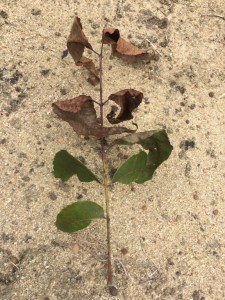Here is a pecan insect update from UGA Entomologist, Dr. Will Hudson:
The yellow aphid spike many growers noticed in late June seems to have fallen off in most orchards, and the very hot weather now will really slow any further population increases. That takes some pressure off for now. I’ve had some calls and seen some leaf scorch in scattered orchards in middle GA, and some growers are worried it is mite damage. I don’t know what the cause IS, but I know it is NOT mites. Typical symptoms are the terminal leaflets turn gray-brown and wither, followed by the lower leaflets until the whole compound leaf drops. Mites cannot cause that type of symptom although there often are mites on the leaves. Spraying with a miticides will not help the situation.
If mite populations do approach damaging levels, Abamectin would be a good choice at this time. Be sure and consult the label for specific rates on Abamectin as there are several generic products out there with varying amounts of active ingredient. The heaviest pressure from mites is normally in mid to late August or following weevil sprays so save the more expensive and longer residual materials like Envidor and Portal for that time. Nexter could also be used where aphids are a problem as well.
I’ve also had some calls about webworms, especially in young orchards. Probably the cheapest effective treatment that will give long lasting control is Dimilin. The material is absorbed into the leaves and persists until the leaves fall, so one shot should hold for most of the rest of the season unless you get another flush of new growth. For small trees 4-8 oz will give good control of most caterpillar pests.
Follow up by Dr. Wells on the leaf scorching:
We have had calls from a number of orchards throughout the state over the last week with some leaf scorching symptoms that start from the tip of the compound leaflet and move backward. Eventually the entire compound leaf will turn brown and has a similar appearance to fire blight. This results form a fungal infection by a relatively minor pathogen called Neofusicoccum. Terminal die back is a common name for it. Once you see the symptoms it is too late to do anything about it. We see this pop up periodically under the right conditions, normally later in the season; however, never to a level of economic damage. See previous post here for more info.

